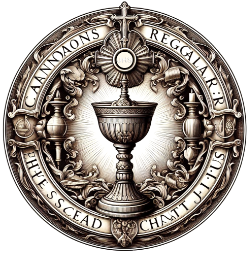Liturgical Colours
Liturgical colours in the Roman Catholic tradition serve as a visual theology, expressing the spiritual tone of the Church’s seasons and feasts. Each hue carries symbolic weight, shaping the faithful’s experience of the sacred mysteries.
White or Gold
White, often interchangeable with gold, signifies *purity, joy, and glory*. It is the colour of the Resurrection and is used during the most exalted celebrations: Christmas, Easter, feasts of the Lord (excluding those of His Passion), Marian solemnities, and the feasts of saints who were not martyrs. Gold, while not a separate liturgical colour, may replace any other colour on solemn occasions, emphasizing festivity and divine majesty. These colours evoke the light of Christ and the triumph of life over death.
Red
Red symbolizes *the Holy Spirit and the blood of martyrdom*. It is used on Palm Sunday, Good Friday, Pentecost, and the feasts of Apostles, Evangelists, and martyrs. The fiery tone recalls the tongues of flame at Pentecost and the sacrificial love of Christ and His witnesses. Red thus bridges the themes of divine power and human sacrifice, uniting the Spirit’s descent with the Church’s witness through suffering.
Green
Green, the colour of *hope and growth*, dominates Ordinary Time. It reflects the ongoing journey of the Church between major liturgical seasons, inviting the faithful to spiritual maturity and perseverance. Its natural tone suggests the vitality of grace at work in the everyday rhythms of Christian life. Though less dramatic than other colours, green’s constancy mirrors the enduring presence of God in the ordinary.
Purple or Violet
Purple, or violet, denotes *penance, preparation, and solemnity*. It is worn during Advent and Lent, seasons of anticipation and conversion. The colour’s richness conveys both the dignity of the coming King and the gravity of repentance. It is also used for the Sacrament of Penance and on All Souls’ Day. Violet’s dual symbolism—royalty and mourning—captures the paradox of Christian waiting: joyful expectation tempered by the call to interior renewal.
Black
Though now rarely used, black traditionally represents *mourning and the reality of death*. It is permitted for All Souls’ Day and funeral Masses, especially in cultures where it resonates deeply. Black’s starkness confronts the mystery of mortality, yet within the liturgy, it is never without hope. Its use underscores the Church’s prayerful solidarity with the dead and the sober truth of human finitude.
Together, these colours form a sacred palette, guiding the faithful through the liturgical year. They do not merely decorate the sanctuary; they preach, in silence, the mysteries of Christ. Whether in the brilliance of white or the shadow of black, each hue invites deeper contemplation of the divine drama unfolding in time.
The video illustrates a solemn Elevation during a Traditional Latin Mass at the Church of St. John Cantius, in Chicago. Note all the vestments and the context they are used at that particular high moment of the Liturgy.
Historical Context
The historical development of liturgical colours in the Roman Catholic Church reflects a gradual evolution from practical vestments to a richly symbolic system that shapes the rhythm of the liturgical year.
Early Christian Simplicity
In the earliest centuries, there was no formal colour scheme. Clergy wore their finest garments—often white or natural tones—without symbolic intent. Vestments were adaptations of Roman civil dress, and distinctions between sacred and secular attire were minimal. The emphasis lay more on dignity and reverence than on colour symbolism.
Emergence of Colour Usage
By the 9th century, we begin to see references to specific colours for certain feasts. The Ordo of St. Amand mentions dark vestments for penitential days and black for the Feast of the Purification. However, these practices varied widely by region, and there was no universal standard. The Carolingian period saw experimentation, with churches using a range of colours—sometimes guided more by availability than theology.
Codification in the High Middle Ages
A turning point came in the 12th century when Pope Innocent III, in De Sacro Altaris Mysterio, outlined a more structured use of colours: white, red, green, black, and violet. This marked the beginning of a standardized Roman usage, though local variations persisted. The symbolism of each colour began to crystallize—white for purity, red for martyrdom, green for hope, violet for penance, and black for mourning.
Tridentine Council -> Baroque Era
The Council of Trent (1545–1563) reinforced uniformity in liturgical practice, including colours. The Roman Missal of 1570 codified the colour scheme, which remained largely unchanged for centuries. During the Baroque era, the use of luxurious fabrics and elaborate embroidery enhanced the visual impact of liturgical colours, deepening their catechetical function.
Modern and Pastoral Adaptation
The Second Vatican Council (1962–1965) retained the traditional colours but allowed for pastoral flexibility. The 1969 General Instruction of the Roman Missal reaffirmed the core palette while permitting gold or silver vestments on solemn occasions and regional adaptations with episcopal approval. This balance of tradition and adaptability reflects the Church’s desire to preserve meaning while engaging contemporary sensibilities.
In essence, liturgical colours evolved from practical garments to a theological language of their own. They now serve not only to adorn the liturgy but to preach silently, guiding the faithful through the mysteries of Christ with the eloquence of colour.









